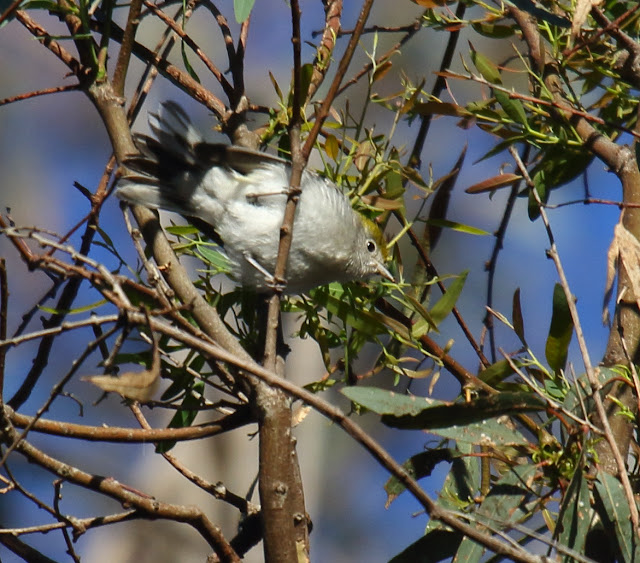eBird told me I saw 3 birds in a visit to New York in May 1982 and vagrants twice in Oregon in May 1999 and July 2003. As "Nancy's bird" stuck around for more than a month, and was not too far from my home, I decided to go look for it one sunny morning before work.
I spent about a half hour watching many NON-Chestnut-sided Warblers chase insects in the first rays of sun on the eastern edge of the specified grove of trees. It was frosty in the shade, but with my back grabbing the sun's meager warmth it was tolerable. Then I encountered Stevan Brad also looking for the bird. After another half hour I spotted the target bird inside the grove rather than on the sunny edge. I called Stevan over and we both got great looks and some workable photographs.
This is probably a first-year female, totally lacking its namesake chestnut sides. The lime green crown, thin white eye ring, and two ample wing bars clinch the ID, though.
 |
| Chestnut-sided Warbler, Carlsbad, California. January 4, 2019. |
What is a "Lerpy Eucalyptus"? I had encountered this term numerous time on the San Diego bird listserv, but nowhere else. Nancy's description of the location of this bird was that it was in a "grove of lerpy euc." However, no Google search turned up any helpful information. In fact, if you search today for "lerpy eucalyptus" it changes your first search term from lerpy to Leroy!
Lerpy eucalyptus refers to a eucalyptus tree infested with lerps. Lerps, according to a very unhelpful Wikipedia entry, are a crystalized honeydew produced by the larvae of psyllid bugs as a protective cover. Interpretation: See those white bumps on the leaves in the above two photos? Yes, I think those are the infamous lerps!
[As I put the final edits on this post I note this term is described in an upcoming new book by the Natural History Museum of Los Angeles County, Gregory B. Pauly et al., called Wild L.A. (March 2019 publication date). Quoting from this book that doesn't exist yet: "In nature, a lerp is the sugary protective covering produced by larvae of psyllid bugs. These bugs are commonly known as lerp insects, and when they infest a tree, birds like warblers swarm in to feast. Birders love to find lerpy eucs (eucalyptus trees)--that's where the birds are."]
There have been 3-6 Chestnut-sided Warblers reported in San Diego County on average over the past few years, primarily during the fall migration, September to October. Thus it was very obliging of this bird to remain for the winter.
More photos of Chestnut-sided Warblers in San Diego from eBird. Click on the photos to rate (1 awful, 2 poor but identifiable, 3 average or small, 4 very good, 5 magazine cover worthy).




I didn't realize it before reading this again, but I've seen Chestnut-sided Warbler just once in four successive decades!
ReplyDeleteThank you! I’m relatively new to the listserv and have not been able to figure out what this phrase means!
ReplyDelete~Erin W,
Bay Park